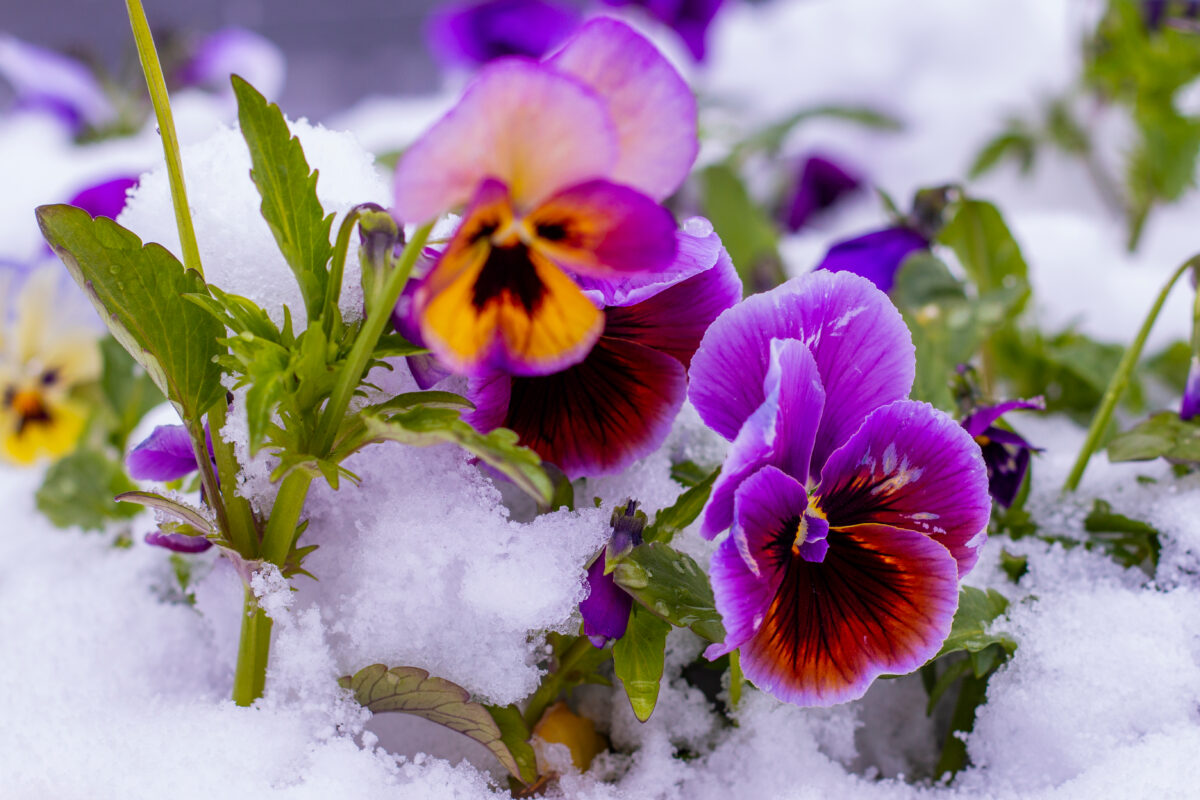The Best Flowers to Plant in Winter

Choosing winter flowers for landscaping in the Northeast involves selecting plants that can withstand the cold temperatures and add color and interest to your outdoor space during the colder months. The best flowers to plant in winter are flowers that bloom in winter or early spring as well as those that add visual interest, even in the snow, such as evergreens or those with colorful bark or berries.
Understanding the Northeast’s Climate
The winter climate in the Northeastern United States varies, but generally, it is cold with the possibility of snow and freezing temperatures. When landscaping in the Northeast during winter, it is advisable to select plants that are hardy and can withstand cold temperatures, as well as to plan for snow and ice management to maintain safety and aesthetics. Additionally, incorporating evergreen plants can improve year-round appeal of the landscape.
Top Winter-Resilient Flowers and Plants
Choosing winter-resilient outdoor flowers and plants is crucial for maintaining an attractive landscape during the colder months. Some examples of plants that are known for their resilience in winter conditions in the Northeast include:
- Winterberry (Ilex verticillata): This deciduous holly shrub produces bright red berries in the winter, providing a splash of color against the snow. Both male and female winterberry plants are necessary for the cross pollination that produces berries.
- Pansies (Viola): Pansies are hardy annuals that can withstand chilly temperatures and even bloom during the winter in milder periods. Pansies also tend to drop seeds and may spring back up without replanting, despite their classification as an annual plant.
- Witch Hazel (Hamamelis): The winter-flowering variety of witch hazel produces unique, spidery flowers in late fall and winter, adding interest to the winter landscape.
- Hellebores (Helleborus): Also known as Lenten Rose, hellebores are a very hardy flower that blooms in late winter and early spring, offering a range of colors and staying green throughout the winter.
- Winter Jasmine (Jasminum nudiflorum): This deciduous shrub produces bright yellow flowers during the winter, adding a burst of color to late winter or early spring landscapes.
- Snowdrops (Galanthus): Snowdrops are early blooming bulbs that produce small, white flowers. Plants can push through the snow and bloom early, symbolizing the arrival of spring.
- Red Twig Dogwood (Cornus sericea): Known for its vibrant red stems, this shrub adds winter interest to a landscape, especially against a snowy backdrop.
- Evergreen Conifers (e.g., Spruce, Pine, Fir): Evergreen trees and shrubs retain their foliage throughout the winter, providing color and structure to any landscape.
- Bergenia (Bergenia cordifolia): This hardy perennial has evergreen leaves and produces pink or white flowers in late winter or early spring.
- Japanese Andromeda (Pieris japonica): With attractive foliage and cascading clusters of flowers, Japanese Andromeda adds interest to a winter garden.
When planning a winter-resilient landscape, consider a mix of these plants to ensure continuous visual appeal, even in colder months. Additionally, mulching properly and protecting plants from harsh winds can contribute to their winter survival.
Strategic Plant Placement for Maximum Impact
When planning winter landscaping, it is important to consider factors such as plant hardiness, visual interest, and the overall design of the outdoor space. Start with these tips on how to strategically place plants for winter landscaping and outdoor flowers:
- Understand Hardiness Zones: When planning any landscaping project, it is important to be familiar with the USDA Hardiness Zones specific to the region. Hardiness zones provide information about the average minimum winter temperatures in different areas. Choose plants that are well-suited to your hardiness zone to ensure their survival in winter.
- Evergreen Placement: Incorporate evergreen plants strategically throughout the landscape. Evergreens, such as conifers and hollies, provide year-round color and structure and should be placed in locations where they can serve as focal points or act as a backdrop for other plants.
- Consider Winter Bloomers: Select plants that bloom during the winter months. Winter blooming flowers, such as hellebores or winter jasmine, can add bursts of color and interest to the landscape when other plants are dormant.
- Group Plants with Similar Winter Appeal: Arrange plants with similar winter appeal together. For example, group plants with interesting bark, such as red twig dogwood, to create a visually appealing winter display.
- Balance Shapes and Sizes: Create balance in a winter landscape by considering the shapes and sizes of the plants. Combine tall and short plants and mix different shapes to achieve a harmonious and visually interesting arrangement.
- Wind Protection: Use evergreen shrubs or other plants strategically to provide wind protection for more delicate plants, which can help reduce winter desiccation and protect plants from harsh winter winds.
- Account for Snow Accumulation: Be mindful of potential snow accumulation in each chosen plant location. Avoid placing plants directly in areas where heavy snowfall from roofs may damage them.
By taking these factors into account, homeowners can create a well-designed winter landscape that not only survives the colder months, but also adds beauty and interest to their outdoor space during the winter season.
Complementary Elements for a Winter Garden
Creating a winter garden with complementary elements involves selecting plants, structures, and features that work together harmoniously to provide visual interest and enhance the beauty of the landscape during the colder months. In addition to plants that bloom in late winter or evergreens that stay lush through the year, adding complementary elements can ensure that a home lawn stays beautiful, no matter what the weather. Some elements that may add interest include:
- Stone pathways
- Outdoor art or sculptures
- Bird feeders and bird baths
- Seasonal porch decor
- Winter friendly planted containers
By combining these complementary elements, homeowners can design a winter garden that is not only visually appealing, but also functional and inviting during the winter months.
Preparing Your Lawn for Winter with Gallivan’s Expertise
Planning a landscape that will survive and thrive in the winter is paramount in preserving curb appeal. However, some aspects of a home’s landscape may need to be prepared for winter, even if they will not stay green and blooming. One way to ensure that a property is ready for cold winter months is to get started with Gallivan Corporation. The landscaping experts at Gallivan can help homeowners at virtually any point in the landscaping process, from implementing a complete overhaul to general lawn maintenance to winterization.
Incorporating Seasonal Flower Rotation
As noted above, many flowers and foliage can thrive and add color to a landscape, even in the winter. However, relying only on winter-resistant plants can lead to a spring that may be begging for more color. The landscapers at Gallivan offer a professional annual flower rotation service that helps homeowners maintain a vibrant landscape throughout the year. Gallivan will rotate plants according to their blooming seasons, ensuring there are always stunning pops of color outside your door. The results of flower rotation include year-round visual appeal and healthier soil.
Custom Landscape Solutions from Gallivan
Planning, planting, and maintaining a beautiful landscaping plan requires a lot of work and a lot of knowledge about plants, flowers, seasonality, and landscape maintenance. Many homeowners understandably do not have the time or desire to do all their own landscaping, which is the best reason to turn to the landscaping experts at Gallivan.
Rather than settling for what you can accomplish by devoting every hard-earned weekend to your lawn, consider custom landscaping solutions from Gallivan. With more than 30 years of experience in the Northeast, the team at Gallivan is dedicated to helping homeowners turn their outdoor spaces into welcoming oases for all seasons. From selecting the right plants and locations to plant them to implementing regular landscape management and setting up holiday decorations, Gallivan is ready to elevate the outdoor look of your home.
Reach out today to learn how Gallivan can help with your next landscaping project.
